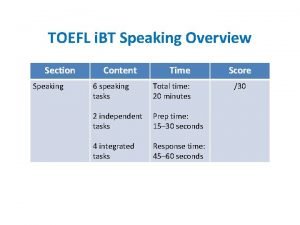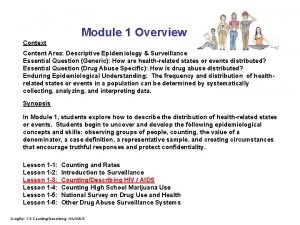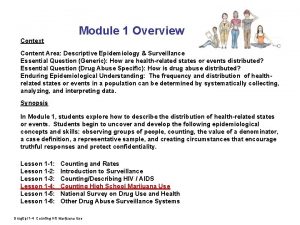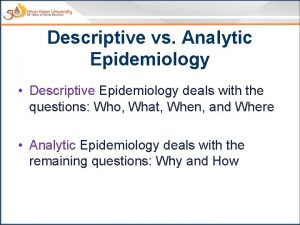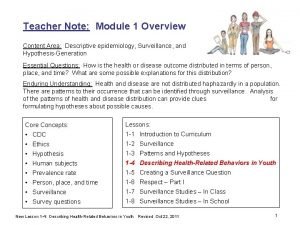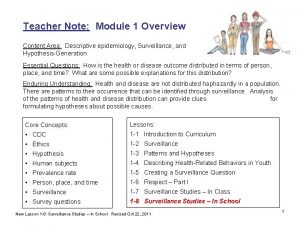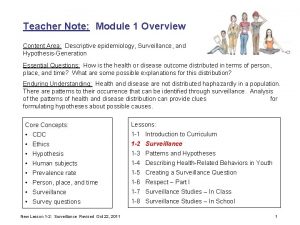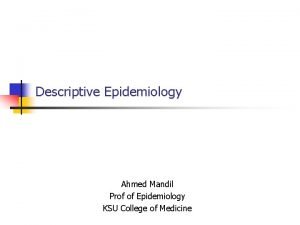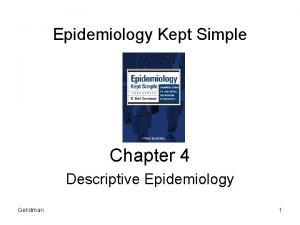Module 1 Overview Context Content Area Descriptive Epidemiology



























- Slides: 27

Module 1 Overview Context Content Area: Descriptive Epidemiology & Surveillance Essential Question (Generic): How are health-related states or events distributed? Essential Question (Drug Abuse Specific): How is drug abuse distributed? Enduring Epidemiological Understanding: The frequency and distribution of healthrelated states or events in a population can be determined by systematically collecting, analyzing, and interpreting data. Synopsis In Module 1, students explore how to describe the distribution of health-related states or events. Students begin to uncover and develop the following epidemiological concepts and skills: observing groups of people, counting, the value of a denominator, a case definition, a representative sample, and creating circumstances that encourage truthful responses and protect confidentiality. Lesson 1 -1: Lesson 1 -2: Lesson 1 -3: Lesson 1 -4: Lesson 1 -5: Lesson 1 -6: Counting and Rates Introduction to Surveillance Counting/Describing HIV / AIDS Counting High School Marijuana Use National Survey on Drug Use and Health Other Drug Abuse Surveillance Systems Drug. Epi 1 -2 Introduction to Surveillance

Module 1 - Descriptive Epidemiology and Surveillance Lesson 1 -2 Introduction to Surveillance Content • Surveillance in everyday life • Definition of surveillance as it pertains to descriptive epidemiology and to public health • Uses of public health surveillance information • Important considerations in conducting public health surveillance (justification for surveillance efforts, case definitions, surveillance population, surveillance methods, quality of the information collected, ethics) Big Ideas • Surveillance has an important role in describing the public’s health • In order to be useful, surveillance information has to be accurate and representative of the population of interest, collected and used in an ethical manner, and communicated appropriately to all who have a need to know. This project is supported by a Science Education Drug Abuse Partnership Award, Grant Number 1 R 24 DA 016357 -01, from the National Institute on Drug Abuse, National Institutes of Health. Drug. Epi 1 -2 Introduction to Surveillance

Where are we? Essential Questions Enduring Understandings 1. How is this disease distributed? Health-related conditions and behaviors are not distributed uniformly in a population. They have unique distributions that can be described by how they are distributed in terms of person, place, and time. 2. What hypotheses might explain the distribution of disease? Clues formulating hypotheses can be found by observing the way a health-related condition or behavior is distributed in a population. 3. Is there an association between the hypothesized cause and the disease? Causal hypotheses can be tested by observing exposures and diseases of people as they go about their daily lives. Information from these observational studies can be used to make and compare rates and identify associations. 4. Is the association causal? Causation is only one explanation for an association between an exposure and a disease. Because observational studies are complicated by factors not controlled by the observer, other explanations also must be considered. 5. What should be done when preventable causes of disease are found? Policy decisions are based on more than the scientific evidence. Because of competing values - social, economic, ethical, environmental, cultural, and political factors may also be considered. Drug. Epi 1 -2 Introduction to Surveillance

Review - Descriptive Epidemiology DZ DZ Characterizes the amount (counts) and distribution (person, place and time) of health and disease within a population Robert H. Friis and Thomas A. Sellers, Epidemiology for Public Health Practice, 3 rd Edition Drug. Epi 1 -2 Introduction to Surveillance

Descriptive Epidemiology In other words, the descriptive epidemiology describes occurrence of a disease or condition in terms of its counts and rates in different locations and time frames, and by the personal, societal, and environmentally-related characteristics of people who get the disease or have the condition Drug. Epi 1 -2 Introduction to Surveillance

Examples of Scope of Descriptive Epidemiology Local Investigation US Surveillance Global Surveillance Possible Food Poisoning Drug Use Surveys Cancer Incidence in Suspected Cluster of Childhood Leukemia Legionella Outbreak Drug. Epi 1 -2 Introduction to Surveillance Birth Defects Registries Five Continents State Cancer Registries Many Communicable Diseases (CDC) National Death Index HIV/AIDS (WHO)

Surveillance DZ DZ This lesson will explain how SURVEILLANCE is one tool for collecting descriptive epidemiologic data Drug. Epi 1 -2 Introduction to Surveillance

Definition of Surveillance The close and continuous observation of one or more persons for the purpose of direction, supervision, or control Webster’s Third International Dictionary Drug. Epi 1 -2 Introduction to Surveillance

Traffic Surveillance The close and continuous observation of one or more persons the purpose of direction, supervision, or control Drug. Epi 1 -2 Introduction to Surveillance for

Traffic Surveillance The close and continuous observation of one or more persons the purpose of direction, supervision, or control Drug. Epi 1 -2 Introduction to Surveillance for

Military Surveillance The close and continuous observation of one or more persons the purpose of direction, supervision, or control Drug. Epi 1 -2 Introduction to Surveillance for

Hotel Surveillance The close and continuous observation of one or more persons the purpose of direction, supervision, or control Drug. Epi 1 -2 Introduction to Surveillance for

ATM Surveillance The close and continuous observation of one or more persons the purpose of direction, supervision, or control Drug. Epi 1 -2 Introduction to Surveillance for

Public Health Surveillance The close and continuous observation of one or more persons for the purpose of direction, supervision, or control Drug. Epi 1 -2 Introduction to Surveillance

Definition of Public Health Surveillance The ongoing systematic collection, analysis, and interpretation of outcome-specific data All types of data collected from populations that could be useful in guiding public health activities. Drug. Epi 1 -2 Introduction to Surveillance for use in planning, implementation, and evaluation of public health practice closely integrated with the timely dissemination of these data to those who need to know.

Public Health Surveillance: Provides Descriptive Epidemiology Public Health Surveillance Drug. Epi 1 -2 Introduction to Surveillance Descriptive Epidemiology

Current Uses of Public Health Surveillance Information Assessment of the status of a health condition Establishment of priorities Evaluation of programs Conduct of research Drug. Epi 1 -2 Introduction to Surveillance

Important Considerations in Public Health Surveillance 1. Significance of Problem Is the effort justified? 2. Case Definition What is the condition under surveillance? 3. Surveillance Population Who will be surveyed? 4. Surveillance Methods How will the surveillance be conducted? 5. Quality of Surveillance Information What are the strengths and limitations of the surveillance results? 6. Ethics Is the information being collected and used in an ethical manner? Drug. Epi 1 -2 Introduction to Surveillance

1. Significance of Problem Does the health problem justify surveillance? There is a need to identify the high priority health-related events that warrant the effort and cost of surveillance • Frequency • Severity • Cost • Preventability • Communicability • Public Interest Drug. Epi 1 -2 Introduction to Surveillance

2. Case Definition What is the condition under surveillance? Case Definition A set of standard criteria for deciding whether a person has a particular disease or other health-related condition. Drug. Epi 1 -2 Introduction to Surveillance

3. Surveillance Population Who will be surveyed? Drug. Epi 1 -2 Introduction to Surveillance

3. Surveillance Population Sampling Frame The set of people from which the potential survey participants will be selected Probability Sampling A subset of a population from which all individuals have a known chance of being selected Drug. Epi 1 -2 Introduction to Surveillance

4. Surveillance Methods How will the surveillance be conducted? • New data via a survey? - Sampling - Data collection - Designing questions - Interview techniques • Existing data? - Sources (e. g. , hospitals, police records, cancer registries) • Active or passive? Drug. Epi 1 -2 Introduction to Surveillance

5. Quality of Surveillance Information What are the strengths and limitations of the surveillance results? ● Data accuracy? - Clear, non-ambiguous, non-threatening questions - Truthfulness, comfort of participants - Objectivity of researchers - Quality of measurement - Accuracy in data entry and transfer ● Data completeness? - Response rate / effective survey logistics - Reasonable length of survey so participants to not give up - Percent of questions answered, response rate ● Sample representative of base population? Drug. Epi 1 -2 Introduction to Surveillance

6. Ethics Is the information being collected and used in an ethical manner? First, what do we mean by “ethics”? ● Accepted principles of right and wrong governing the conduct of a group ● In human health research, the three main ethical principles are: 1. Respect for persons 2. Doing no harm (beneficence) 3. Justice Drug. Epi 1 -2 Introduction to Surveillance

6. Ethics 1. Respect for persons - people are autonomous / can make their own decisions, and also, if their autonomy is impaired, they are entitled to protection ● Participants should have full information about the study/survey - Often requires an informed consent form that documents what the study participant understands about the study and his/her participation ● Participants should know that participation is strictly voluntary - this important principle also stipulates that a participant can withdraw from the study at any time without repercussions Drug. Epi 1 -2 Introduction to Surveillance

Next Lesson (1 -3) HIV / AIDS Surveillance 1. Significance of Problem 2. Case Definition 3. Surveillance Population 4. Surveillance Methods 5. Quality of Surveillance Information 6. Ethics Drug. Epi 1 -2 Introduction to Surveillance
 Classification of epidemiological studies
Classification of epidemiological studies Thesourceagents
Thesourceagents Descriptive vs analytical epidemiology
Descriptive vs analytical epidemiology Difference between descriptive and analytical epidemiology
Difference between descriptive and analytical epidemiology What is descriptive study in epidemiology
What is descriptive study in epidemiology Person place and time model in epidemiology
Person place and time model in epidemiology Database content management system
Database content management system Toefl i
Toefl i Carrier content vs real content
Carrier content vs real content Static content vs dynamic content
Static content vs dynamic content Content analysis interviews
Content analysis interviews Virgen de guadalupe
Virgen de guadalupe Nonagist
Nonagist High context vs low context culture ppt
High context vs low context culture ppt Physical context and linguistic context
Physical context and linguistic context Contoh low context culture
Contoh low context culture C device module module 1
C device module module 1 Ukuran asosiasi epidemiologi
Ukuran asosiasi epidemiologi Nutritional epidemiology definition
Nutritional epidemiology definition Logistic regression epidemiology
Logistic regression epidemiology Prevalence calculation
Prevalence calculation Attack rate calculation
Attack rate calculation Bibliography of epidemiology
Bibliography of epidemiology Association and causation
Association and causation Attack rate epidemiology formula
Attack rate epidemiology formula Ramboman
Ramboman Biologic plausibility
Biologic plausibility Period prevalence formula
Period prevalence formula







